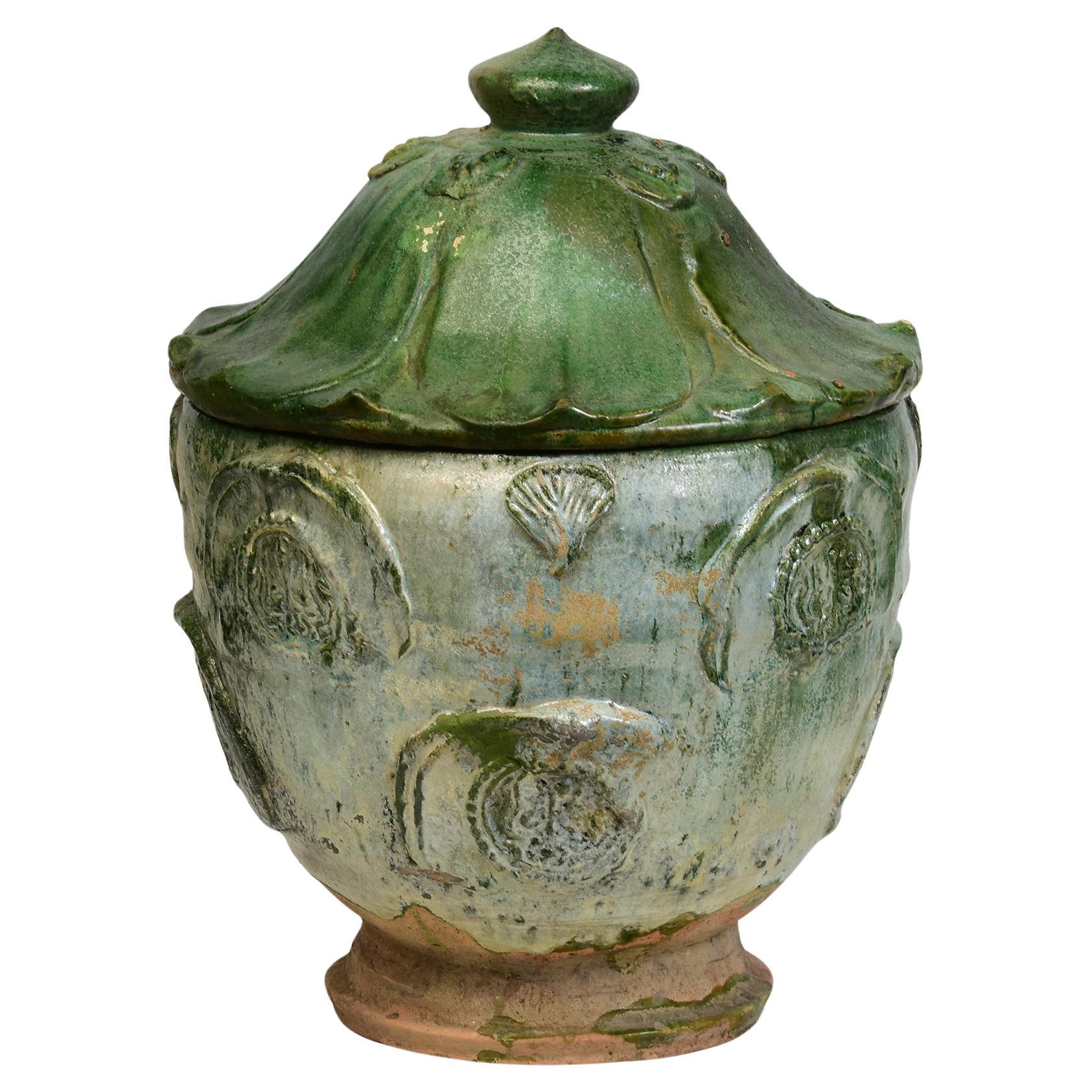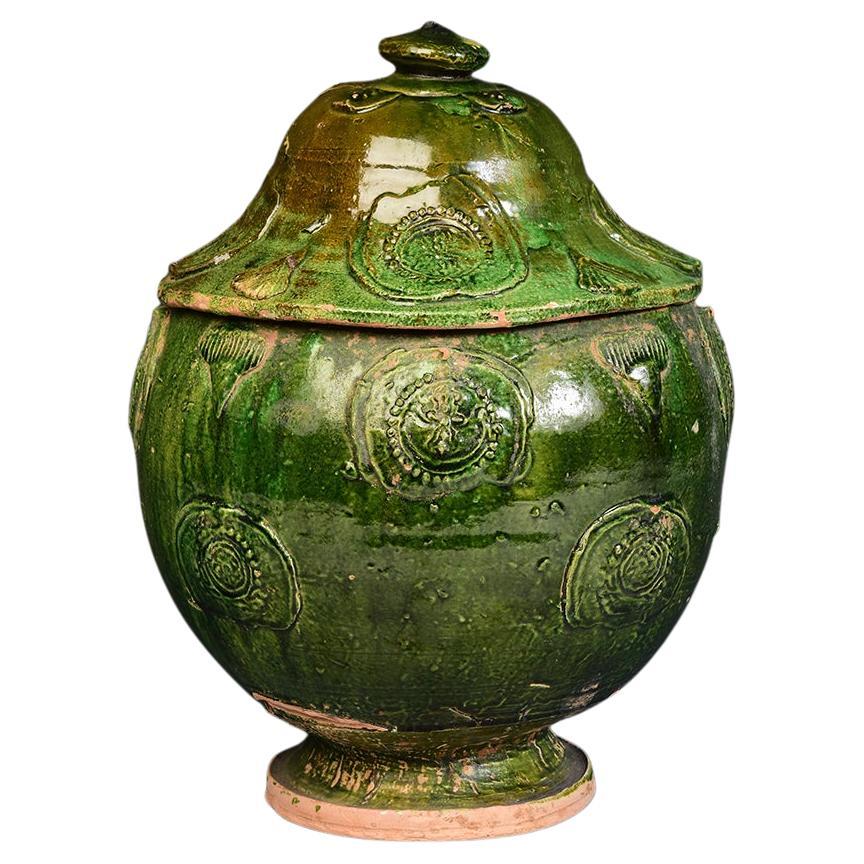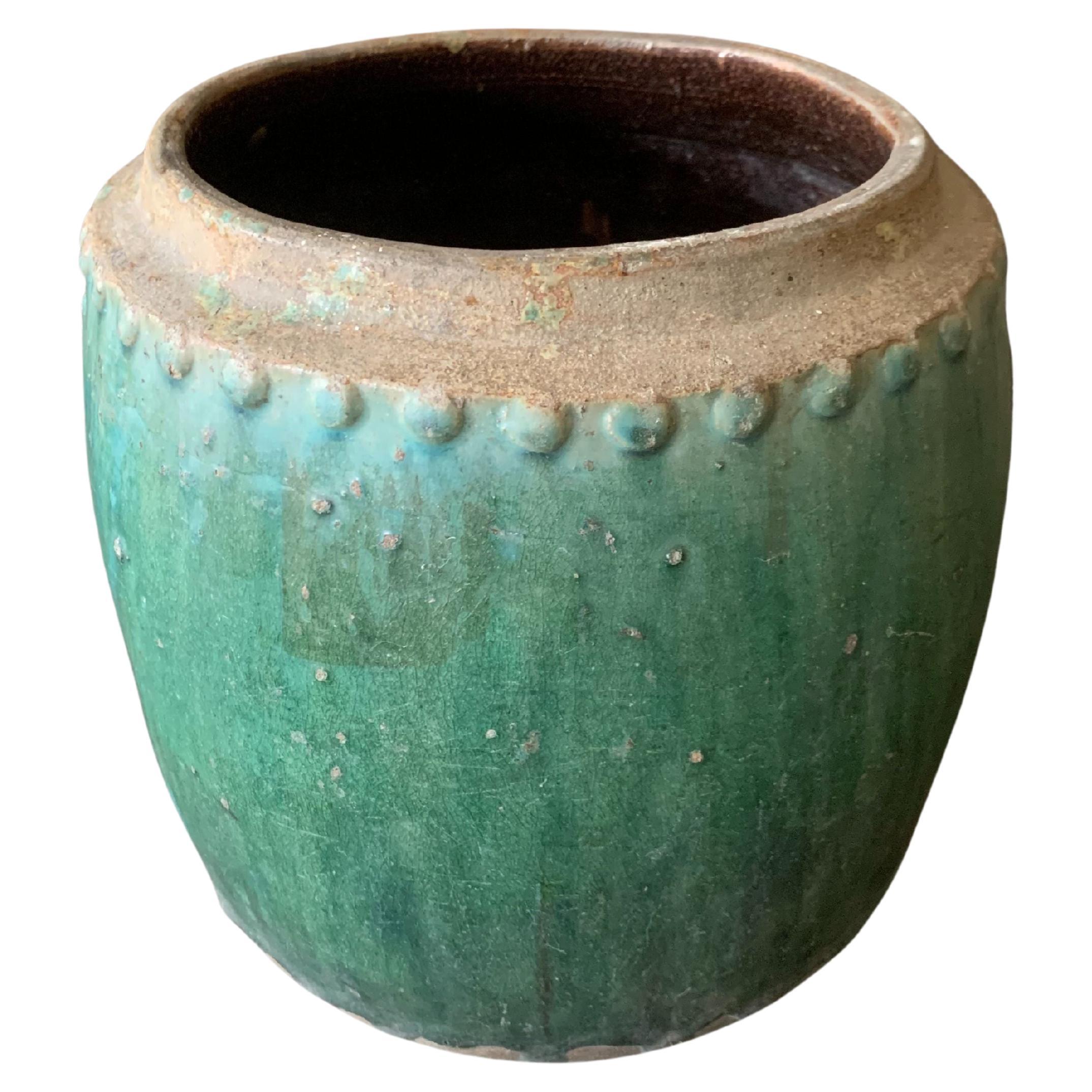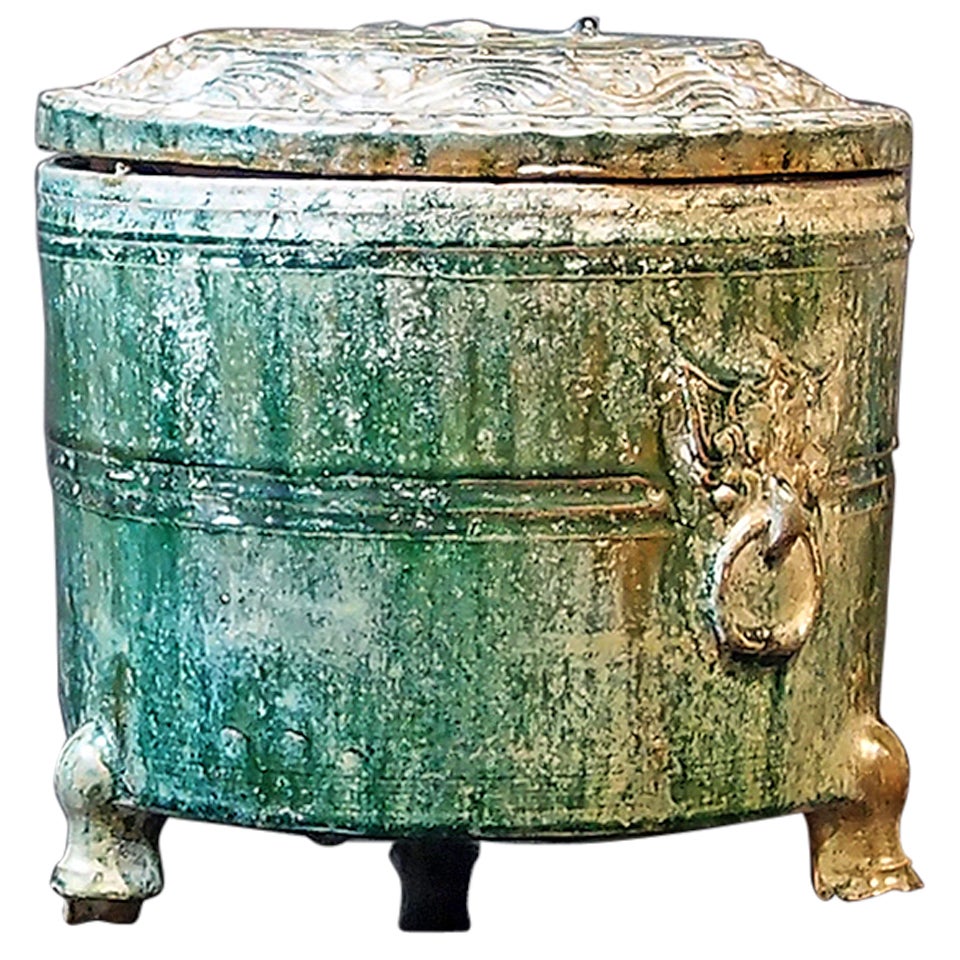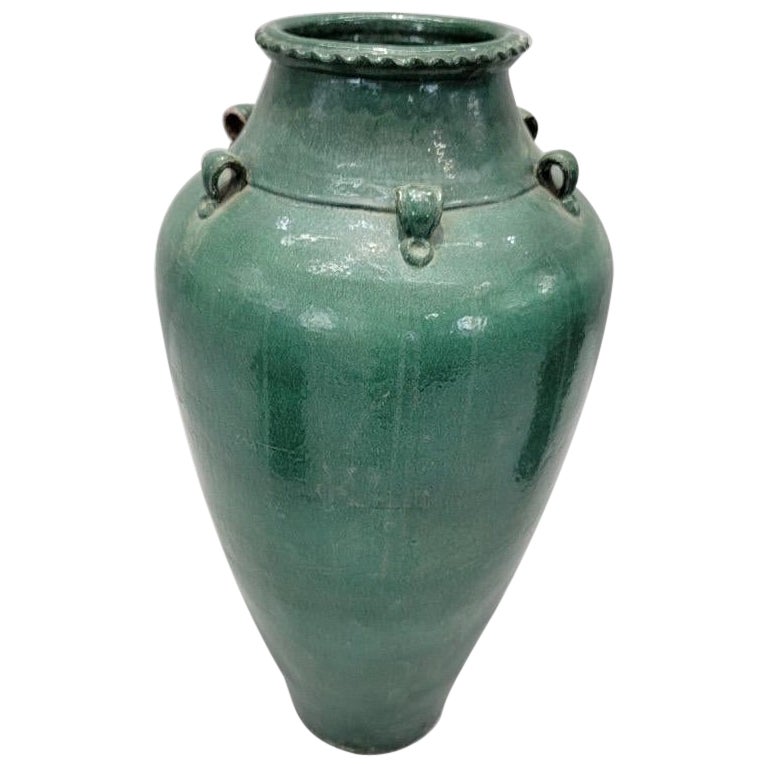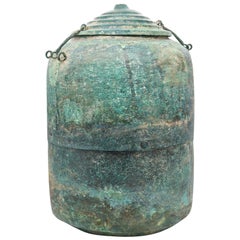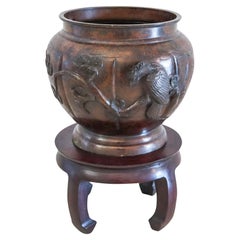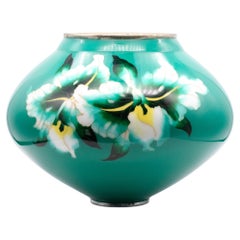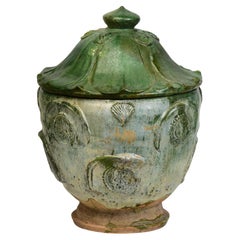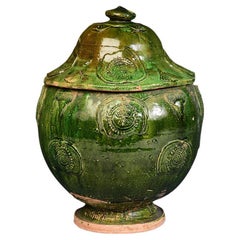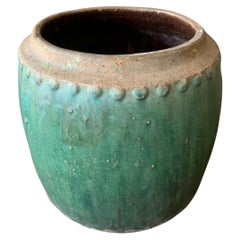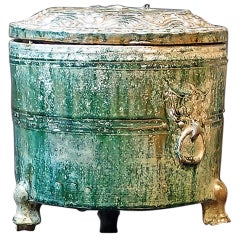Items Similar to YUAN DYNASTY 1300 AD Green Glazed Large Lidded Vessel With Lotus Relief
Want more images or videos?
Request additional images or videos from the seller
1 of 11
YUAN DYNASTY 1300 AD Green Glazed Large Lidded Vessel With Lotus Relief
$5,750
£4,362.97
€4,988.66
CA$8,031.19
A$8,929.59
CHF 4,662.54
MX$108,694.87
NOK 59,491.98
SEK 55,741.14
DKK 37,231.31
Shipping
Retrieving quote...The 1stDibs Promise:
Authenticity Guarantee,
Money-Back Guarantee,
24-Hour Cancellation
About the Item
Green Glazed Large Lidded Vessel from the Yuan Dynasty.
This is a fabulous large lidded vessel from the Yuan Dynasty, circa 14th century. The vessel was made as an offering jar with lotus flowers in high relief. Which are decorated with green-leaf glazed enamel with a lotus design, This terracotta jug was created in the Yuan Dynasty, and delights us with its beautiful design and vibrant color. In the shape of a lotus flower that symbolizes the utmost purity of heart and mind because the flower emerges intact and beautiful from the clay, the bottle is adorned with a green glaze that shows imperfections due to its great age and use. It has a lid with a small handle on top, the jar tapers to its circular base. With its vibrant color and charming silhouette, this Chinese Yuan Dynasty green glazed terracotta lidded lotus jar will make a beautiful decorative addition to any home, perhaps placed on a dresser, side table, sideboard or altar table.
Yuan Dynasty
The Yuan dynasty (1279–1368) was the first foreign-ruled dynasty in Chinese history to commandeer all of China. With no experience in the running of such a large and complex empire, the Mongols gradually adopted many Chinese cultural and bureaucratic models. During the Yuan dynasty, China -for the first time in its long history- was completely subjugated by foreign conquerors and became part of a larger political entity, the vast Mongol empire. Ironically, during this century of alien occupation, Chinese culture not only survived but was reinvigorated.
Measures: Diameter 298.5 mm, height 332.75 mm (11.75 x 13.10 Inches).
Provenance: A private collection in New York city collected in the 1964; T.K. Asian antiquities gallery, Williamsburg Virginia; a private collection in Palm Beach FL; then purchased by James & Nancy Markell, Virginia 1976; then by descent to Lauren Markland, Fort Lauderdale, FL.; acquired in Palm Beach, FL. in March 7, 2021
Condition: The overall condition of this ancient piece is excellent. Beside the little normal wear, there is no damage to any part. This piece has been carefully inspected to guarantee the condition and authenticity. Repaired: Minor repairs and restorations as expected.
INVENTORY REF: D072424DRNM/.6737
- Dimensions:Height: 13.1 in (33.28 cm)Diameter: 11.75 in (29.85 cm)
- Style:Other (Of the Period)
- Materials and Techniques:
- Place of Origin:
- Period:
- Date of Manufacture:1300 AD
- Condition:Wear consistent with age and use. Minor losses. The overall condition of this ancient piece is excellent. Beside the little normal wear, there is no damage to any part. This piece has been carefully inspected to guarantee the condition and authenticity. Repaired: Minor repairs and restorations.
- Seller Location:Miami, FL
- Reference Number:Seller: D072424DRNM/.67371stDibs: LU8303240854042
About the Seller
5.0
Gold Seller
Premium sellers maintaining a 4.3+ rating and 24-hour response times
1stDibs seller since 2023
206 sales on 1stDibs
Typical response time: 4 hours
- ShippingRetrieving quote...Shipping from: Miami, FL
- Return Policy
Authenticity Guarantee
In the unlikely event there’s an issue with an item’s authenticity, contact us within 1 year for a full refund. DetailsMoney-Back Guarantee
If your item is not as described, is damaged in transit, or does not arrive, contact us within 7 days for a full refund. Details24-Hour Cancellation
You have a 24-hour grace period in which to reconsider your purchase, with no questions asked.Vetted Professional Sellers
Our world-class sellers must adhere to strict standards for service and quality, maintaining the integrity of our listings.Price-Match Guarantee
If you find that a seller listed the same item for a lower price elsewhere, we’ll match it.Trusted Global Delivery
Our best-in-class carrier network provides specialized shipping options worldwide, including custom delivery.More From This Seller
View AllQING DYNASTY 1900 Decorative Vase Carved In Translucent Green Fluorite In Stand
Located in Miami, FL
A carved fluorite vase in wood stand.
This is a beautiful decorative oblong flat vase created in the imperial China during the late Qing Dynasty period, circa 1880-1900. The piece h...
Category
Antique Early 1900s Chinese Qing Sculptures and Carvings
Materials
Multi-gemstone
China 960 Ad Song Dynasty Very Rare Imperial Period Offering Vessel in Bronze
Located in Miami, FL
Offering vessel from the Chinese Song Dynasty (960/1279 AD ).
A beautiful "offering spiritual vessel" from the Yunnan province region in the ancient China. This rare vessel was created in red bronze during the Song Dynasty period. between 960/1279 AD.
This is one of the most unusual forms of red bronze jar. A large vessel, the sides are virtually perpendicular to the base. The stepped lid design is also among the more rare types. The predominant lid design among the Yunnan offering bronzes is the "wheel" pattern, with a few lids having the lotus design. This is also one of the few bronzes displaying clear riveting of a two-part vessel body, with the original twisted elements
Has a combined measures including the lid of 12.5 by 8.75 inches (31.75 x 22,23 Cm).
The Song Dynasty, was an imperial dynasty of China that began in 960 and lasted until 1279. The dynasty was founded by Emperor Tizu of Song following his usurpation of the throne of the later Zhou, ending the Five-Dynasties and Ten Kingdoms period. The Song often came into conflict with the contemporaneous Liao, Western Xia and Jin dynasties in northern China. After decades of armed resistance defending southern China, it was eventually conquered by the Mongol-led Yuan dynasty.
The dynasty is divided into two periods: Northern Song and Southern Song...
Category
Antique 15th Century and Earlier Chinese Medieval Antiquities
Materials
Bronze
$3,960 Sale Price
20% Off
JAPAN 1900 Meiji Period Bronze Planter Vase With Carved Wood Base
Located in Miami, FL
Large Planter Vase from imperial Japan.
This a beautiful piece of Japanese decorative arts, created in Japan during the Meiji imperial period, circa 1900. The oversized vase can be ...
Category
Antique Early 1900s Japanese Meiji Metalwork
Materials
Bronze
Ando Jubei Japan 1950 Showa Period Cloisonné Enamel Green Bombe Vase
By Ando Jubei
Located in Miami, FL
Cloisonné enamel vase designed by Ando Jubei.
Beautiful piece of Japanese decorative arts, created by the Ando Jubei Company during the Showa...
Category
Vintage 1950s Japanese Showa Vases
Materials
Silver, Enamel
$1,198 Sale Price
20% Off
Japan 1890 Meiji Period Bronze Koro Censer in Cloisonne Enamel with Jade Lid
Located in Miami, FL
Japanese Koro from the Meiji Period (1868-1912).
Beautiful antique ten sides fluted koro censer, created in Japan during the Meiji period (1868-1912), ci...
Category
Antique 1890s Japanese Meiji Metalwork
Materials
Jade, Gold, Silver, Bronze, Enamel
$718 Sale Price / set
20% Off
Japan 1890 Meiji Period Decorative Vase In Cloisonné Enamel With Wood Base
Located in Miami, FL
Japanese vase from the Meiji Period (1868-1912).
Beautiful antique decorative vase, created in Japan during the Meiji period (1868-1912), circa 1890s. It was carefully crafted in so...
Category
Antique 1890s Japanese Meiji Metalwork
Materials
Bronze, Enamel
$558 Sale Price / set
20% Off
You May Also Like
Yuan Dynasty, Antique Chinese Green Glazed Pottery Covered Jar
Located in Sampantawong, TH
Antique Chinese green glazed pottery covered jar.
Age: China, Yuan Dynasty, A.D. 1271 - 1368
Size: Height 37 C.M. / Width 26.5 C.M.
Condition: Well-preserved old burial condition ov...
Category
Antique 15th Century and Earlier Chinese Antiquities
Materials
Pottery
Yuan Dynasty, Antique Chinese Green Glazed Pottery Covered Jar
Located in Sampantawong, TH
Chinese green glazed pottery covered jar.
Age: China, Yuan Dynasty, A.D. 1271 - 1368
Size: height 35 cm / width 25 cm.
Condition: Wel...
Category
Antique 15th Century and Earlier Chinese Antiquities
Materials
Pottery
$1,560 Sale Price
20% Off
Chinese Shiwan Green Glazed Ceramic Jar / Planter, c. 1900
Located in Jimbaran, Bali
A wonderful green glaze typical of Chinese "Shiwan" pottery adorns this early 20th Century Chinese storage jar. Shiwan ware is a style of Chinese pottery from the Shiwanzhen district...
Category
Early 20th Century Chinese Qing Ceramics
Materials
Ceramic
$388 Sale Price
20% Off
Chinese Han Dynasty Green Glazed Covered Storage Jar
Located in Austin, TX
A wonderful Han Dyansty (206 BC-200 AD) storage vessel. The circular body set upon three legs and fitted with a lid. The entirety covered in heavy leaded green glaze, imitating bronz...
Category
Antique 15th Century and Earlier Chinese Han Antiquities
Materials
Pottery
Chinese Han Dynasty-Style Green Patinated Bronze Lidded Jar
Located in Queens, NY
Antique Chinese Han Dynasty-style copy of a bronze lidded jar decorated with the highs and lows of its green patina, carved with raised geometric patterns and topped with a domed, fi...
Category
20th Century Chinese Chinese Export Jars
Materials
Bronze
Antique Stoneware Large Green-Glazed Mataban Jar
Located in Chicago, IL
Antique Stoneware Large Green-Glazed Mataban Jar
This large antique Chinese urn/jar has six small handles and a shiny green surface. Its sh...
Category
Antique Early 19th Century Chinese Ming Ceramics
Materials
Stoneware
More Ways To Browse
Lotus Asian Art
Clay Relief
Jug With Lid
Long Asian Table
Lotus Ceramics
Century Furniture Asian Sideboard
Chinese Clay Vessel
Green Asian Vessels
Green Glazed Jugs
Terracotta Relief
Chinese Vessel Green Glaze
Sideboard With Flowers
Dynasty Jar Glazed
Used Furniture Williamsburg
Altar Flowers
Chinese Glazed Terracotta
Virginia Galleries Furniture
Antique China Jug
